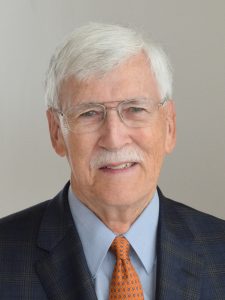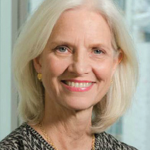June saw the passing of a beloved colleague, mentor and friend to many in the rheumatology community when J. Timothy Harrington, MD, died of pancreatic cancer in his hometown of Madison, Wis.
Dr. Harrington trained at Massachusetts General Hospital, the National Institutes of Health National Cancer Institute and UT Southwestern Medical Center, and served on the faculty at the University of Texas Medical School at San Antonio, before returning to Madison in 1976, where he was a managing partner in his own practice and a professor of medicine at the University of Wisconsin School of Medicine and Public Health until his retirement in 2012.
Dr. Harrington pursued a range of interests over his career in rheumatology, but they all revolved around a central theme: system- and population-based approaches to the delivery of care. He urged us to improve the value of our care, address workforce shortages and reduce the burden on individual providers by redesigning our clinics and hospitals to do the things that individual providers could not do on their own.
Many of his early efforts were in the area of osteoporosis. For example, he drew attention in the early 2000s, several years after the U.S. Food & Drug Administration approved alendronate, to the fact that even patients who had suffered an osteoporotic fracture were not receiving widely available and state-of-the-art management of their disease. He saw similar opportunities in mechanical low back pain, making the case for interdisciplinary, “pre-appointment management” and in the implementation of treat-to-target strategies for rheumatoid arthritis.
His friends and collaborators knew him as engaging and persistent, convinced that we could all do it better. Forever upbeat, he eschewed negativity and invited us, with a smile on his face and a twinkle in his eye, to join him on a path to a better future. He was a visionary and saw the road ahead with greater clarity than most of us. He was impatient for, and unafraid of, change. He published system-based approaches to care that seemed almost avant-garde at the time, but have, in the intervening decades, been widely adopted and are routinely employed today.
Importantly, Dr. Harrington never saw the gaps that he strove to fill as a failing on the part of his colleagues. On the contrary, the shortcomings in the delivery of care in the U.S. were the predictable result, in his eyes, of an ill-designed system that expected increasingly busy clinicians to take care of increasingly complex patients without rationally designed systems to make their work safer, more efficient and more effective.
Dr. Harrington served the rheumatology community through his work with the American Society for Bone and Mineral Research, the Consortium of Rheumatology Researchers of North America, the Rheumatoid Arthritis Practice Performance Project and the ACR, where he was recognized for his outstanding contributions with the Paulding Phelps Award (1993), Master Designation (2003) and the Distinguished Clinician Scholar Award (2019).
William Arnold, MD; Tim Bartholow, MD; Drew Johnson, MS, MBA; Joel Kremer, MD; Daniel Malone, MD; Eric D. Newman, MD; Kenneth Saag, MD; and Douglas White, MD, all contributed to the development of this remembrance.
A Eulogy for J. Timothy Harrington, MD
By Eric D. Newman, MD
Tim and I met through circumstances I don’t remember. Somehow his interests and mine intersected about 20 years ago at an ACR meeting, and we connected. Literally, but also figuratively. Within seconds, we realized we were twin sons of different mothers—both passionate about redesigning care for those we serve, our patients. At that fateful moment, a mentorship, a partnership and an everlasting friendship were simultaneously born.
Tim was several decades ahead of his time. He developed one of the first osteoporosis care programs, focusing on ensuring the right care happened reliably, instead of falling into what he referred to as the Bermuda Triangle of osteoporosis care. A decade or two later came the concept of a fracture liaison service (FLS), which is now a nationally accepted care delivery process operationalized across the country. Tim did it first.
A second example is pre-appointment management. Tim understood before many of us were out of diapers that if you reviewed the correct information prior to blindly scheduling a patient, you could actually get the right patient the right care in the right venue at the right time. That work was published 19 years ago. And that very concept has been learned and relearned and redone a thousand different ways by access mavens, but it all links back to the seminal work Tim put out there.
Enough of his prowess—I want to focus on what Tim’s relationship has meant to me personally. Tim and I worked together on several ACR committees, where I quickly learned that Tim pretty much knew more than anyone else in the room and was not at all afraid of explaining why the traditionalist approach that was advocated would fail and why other alternatives were more viable.
The funny thing is, I was often the only other one in the room who seemed to get it. It was like our brains were somehow wired with the ability to see things not for what they are, but what they could be, the ability to simplify and the passion to challenge oneself with the mantra, “There’s always a better way.” Change was not hard for Tim and me. We ate it for breakfast, lunch and dinner.
Tim mentored me, helped me hone my skills, connected me with like-minded people and set me on a course of far greater success than I ever could have accomplished by myself. For that alone, I am eternally grateful.
Tim was a colleague and a best friend all rolled into one. We both tilted at windmills for a living. Sometimes we would sign our emails as Don Quixote and Sancho Panza, other times as Batman and Robin.
And then came the book. Tim approached me nonchalantly one day and said “Hey, we should write a book together about how to make great healthcare.”
And I said, “Hey, sounds like fun. I’m in.”
And so it began. The most arduous project I had ever undertaken. And the most enjoyable, the most lasting—and the career achievement of which I am the proudest. It truly was a labor of love. And it made an indelible mark on its readers. The best part, however, was getting to work with Tim, putting our creative hats on and getting to tell each other stories—stories of life, stories of family and stories of hope.
I saw Tim last face to face at the ACR/ARP Annual Meeting in Atlanta, November 2019. There, he was receiving his third major international ACR award—the trifecta of perfecta. I spoke with him a few minutes before the award in a packed and noisy auditorium. I always liked to kid Tim, and I commented that he was looking more and more every day like John Bolton. He laughed a bit, but I do believe he thought I said Michael Bolton. We enjoyed a wonderful meal together at the end of the conference—a tradition we both committed to year after year—for there is no better way to close out a trip with a friend than a meal and a cab (the wine, not the vehicle).
As I think about Tim’s many accomplishments and I think about legacy, Tim may have asked himself, what will be left behind? A loving family to be sure. But what about professionally? Well, I think it starts with a cadre of colleagues (and thus, for Tim, friends as well) who not only remember his work, but live it and breathe it and put it into practice every day to help our care teams and our patients.
Tim created a different way of thinking and practicing through expressive writing, such as Great Health Care: Making it Happen and Great Health Care Value, and through process-redesign programs, such as the Rheumatoid Arthritis Practice Performance (RAPP) Project. These accomplishments have transformed how we do what we do—now and for many generations to come.
If, indeed, there is a heaven or a place we all go to after life ends, two things are certain. First, we will meet again, my friend. And second, I give it about a week to a week-and-a-half before you have completely redesigned the afterlife to improve efficiency and effectiveness, and streamline eternal happiness.
You have instilled in us—your friends and family—a yearning to challenge the status quo, to be passionate about not just talking but actually doing, to make a difference and to tilt at those windmills until one day you hit one.
I will forever be, humbly, Sancho to your Don.
Eric Newman, MD, is the director of innovation, Medicine Institute, Geisinger Health System, Danville, Pa.




